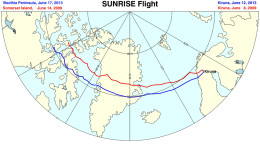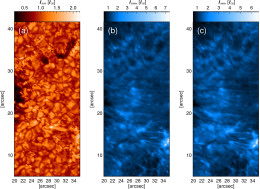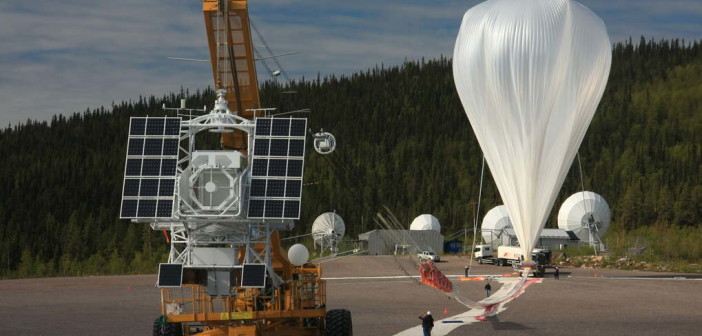
A crane hoists the Sunrise II payload in preparation for its 2013 flight. [Adapted from Solanki et al. 2017]
Airborne Again
This was not Sunrise’s first flight; the 1-meter Gregorian telescope with its two instruments — an imager that took photos at various ultraviolet wavelengths, and a magnetograph that imaged the Sun’s magnetic features — were hoisted into the air once before in a similar flight in 2009. Sunrise I, however, flew during an unexpectedly long activity minimum for the Sun, preventing it from making observations of anything besides the quiet Sun. In contrast, Sunrise II flew at the ideal time to observe the emerging active region NOAA AR 11768 as it developed (see the video below).

The flight paths of the two Sunrise missions. Both launched in northern Sweden, and came down in slightly different locations in northern Canada. [Adapted from Solanki et al. 2017]
Outcomes from Flight
What did scientists discover from the Sunrise II flight? The mission’s primary purpose was to learn about the Sun’s magnetic field and its influence on the solar atmosphere. A few highlights from the mission include:
- Observations of an Ellermann bomb, an explosive event like a tiny solar flare that generally occurs in developing solar active regions. Simulations accompanying Sunrise’s data may help identify where the changes in magnetic field originate that cause these explosions.
- Observations of the dynamics of moving magnetic features close to a pore, a small sunspot that doesn’t have a penumbra.
- Observations that help pinpoint the footpoints of coronal loops (the points where the loops are anchored to the Sun’s photosphere). These regions are discovered to be places of strong magnetic contrasts, and the data indicate the presence of jets at the base of the loop base that might supply plasma to the overlying loop.
- Observations of a network of small, slender fibrils that together form a large-scale magnetic canopy. These fibrils were found to be much longer-lasting than previously realized, and they carry copious amounts of energy via different kinds of waves — possibly playing an important role in heating the chromosphere in active regions.

Sample data from the imaging instrument on board Sunrise II, recorded in three different wavelengths. The two Ca II H channels, shown in the middle and right panels, reveal the presence of long, slender fibrils, many of which seem to emanate from the large pore just to the left of the image. [Solanki et al. 2017]
More analysis is still planned of the data from the first and second flight, so there remain many more discoveries to be made from the first two flights of Sunrise. Meanwhile, since the mission was able to again land with the payload operationally undamaged, the team has already begun plans for a third flight!
For more information on Sunrise II’s results, you can check out the 13 papers the team published in a special issue of the Astrophysical Journal Supplements this week, or you can read the mission overview provided by Sunrise’s PI, Sami Solanki (Max Planck Institute for Solar System Research and Kyung Hee University in Korea).
Bonus
Check out this video from the Solar Dynamics Observatory’s HMI instrument, which shows the evolution of the active region NOAA AR 11768 over the period of time around when Sunrise II observed it.
Citation
S. K. Solanki et al 2017 ApJS 229 2. doi:10.3847/1538-4365/229/1/2

